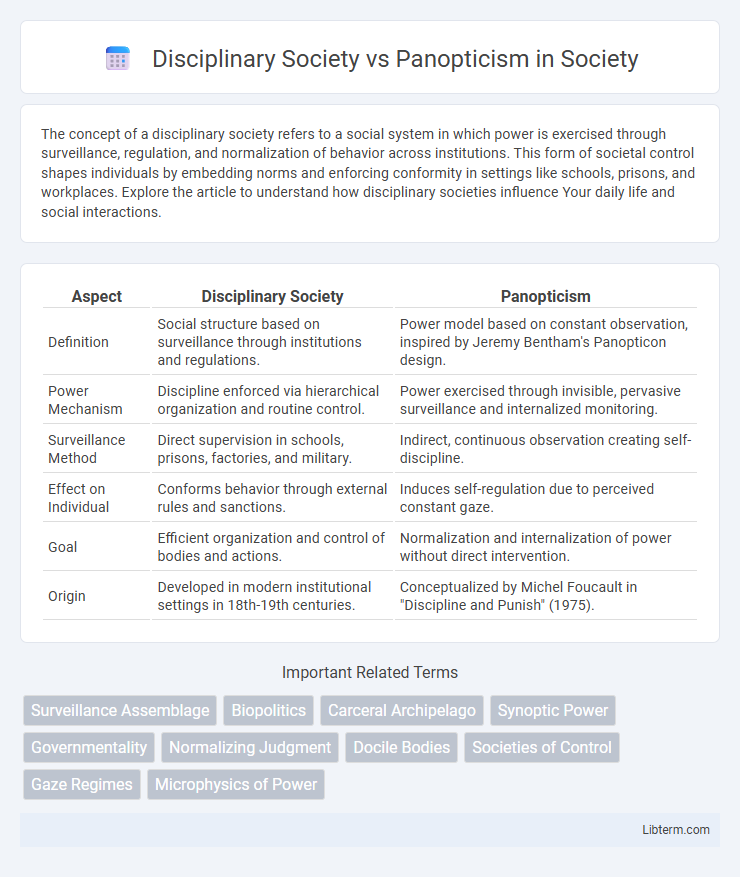The concept of a disciplinary society refers to a social system in which power is exercised through surveillance, regulation, and normalization of behavior across institutions. This form of societal control shapes individuals by embedding norms and enforcing conformity in settings like schools, prisons, and workplaces. Explore the article to understand how disciplinary societies influence Your daily life and social interactions.
Table of Comparison
| Aspect | Disciplinary Society | Panopticism |
|---|---|---|
| Definition | Social structure based on surveillance through institutions and regulations. | Power model based on constant observation, inspired by Jeremy Bentham's Panopticon design. |
| Power Mechanism | Discipline enforced via hierarchical organization and routine control. | Power exercised through invisible, pervasive surveillance and internalized monitoring. |
| Surveillance Method | Direct supervision in schools, prisons, factories, and military. | Indirect, continuous observation creating self-discipline. |
| Effect on Individual | Conforms behavior through external rules and sanctions. | Induces self-regulation due to perceived constant gaze. |
| Goal | Efficient organization and control of bodies and actions. | Normalization and internalization of power without direct intervention. |
| Origin | Developed in modern institutional settings in 18th-19th centuries. | Conceptualized by Michel Foucault in "Discipline and Punish" (1975). |
Introduction to Disciplinary Society and Panopticism
Disciplinary Society, as conceptualized by Michel Foucault, refers to a system of social control characterized by surveillance, normalization, and examination within institutions like schools, prisons, and factories. Panopticism, derived from Jeremy Bentham's Panopticon design, exemplifies a mechanism of power where individuals internalize constant visibility, leading to self-regulation. The introduction of these concepts highlights how modern societies shift from sovereign power to subtle, pervasive disciplinary techniques that shape behavior through architecture and institutional practices.
Historical Origins of Disciplinary Societies
Disciplinary societies emerged in the 17th and 18th centuries as a response to the need for more effective mechanisms of social control and organization within expanding states and institutions. Their historical origins are rooted in the development of modern bureaucracies, military organizations, and educational systems, where discipline was enforced through surveillance, normalization, and systematic training. This contrasts with Panopticism, a concept developed by Michel Foucault, which conceptualizes a pervasive, invisible surveillance system designed to internalize control and discipline within individuals.
Michel Foucault and the Concept of Panopticism
Michel Foucault's concept of Panopticism illustrates a shift from traditional disciplinary societies, where institutions enforce control through visible, localized power structures, to a modern system of pervasive surveillance exemplified by the Panopticon prison design. Panopticism enables constant observation and self-regulation, as the possibility of being watched induces compliance without direct intervention, reflecting modern power dynamics in institutions like schools, hospitals, and workplaces. This mechanism transforms societal control by internalizing discipline, creating a self-monitoring population under the gaze of an invisible, omnipresent authority.
Mechanisms of Surveillance in Disciplinary Societies
Disciplinary societies implement surveillance through hierarchical observation, normalizing judgment, and examinations to regulate individual behavior within institutions like schools, prisons, and factories. Mechanisms include constant monitoring by authorities, the use of detailed records, and standardized assessments designed to discipline bodies and minds systematically. This contrasts with panopticism's architectural design where a central watchtower induces self-surveillance by making individuals internalize the gaze of an unseen observer.
Architecture of Power: The Panopticon Model
The Panopticon model, designed by Jeremy Bentham, epitomizes an architectural structure of power enabling constant surveillance from a central watchtower, fostering self-regulation among inmates. Unlike traditional disciplinary societies, which rely on explicit, physical control mechanisms and hierarchical institutions, Panopticism integrates power subtly through visibility and psychological influence. This architectural paradigm revolutionizes social control by transforming architecture into an instrument of domination that internalizes discipline within individuals.
Individual Behavior and Social Control
Disciplinary society enforces social control through institutions like schools, prisons, and military by regulating individual behavior via hierarchical supervision and detailed surveillance. Panopticism extends this concept by embedding constant, invisible observation into social structures, creating self-discipline through the internalization of surveillance. Both concepts emphasize the transformation of individual behavior into compliance through mechanisms of power and visibility, shaping social order through pervasive control.
Panopticism in Modern Institutions
Panopticism in modern institutions manifests through pervasive surveillance technologies that monitor behavior and enforce conformity, embodying Michel Foucault's concept of invisible power. This form of control extends beyond physical spaces, utilizing data analytics and digital monitoring to regulate actions in workplaces, schools, and public services. The panoptic mechanism fosters self-discipline and compliance by making individuals constantly aware of potential observation, thus reinforcing institutional authority without direct intervention.
Resistance and Subversion in Disciplinary Systems
Disciplinary societies employ hierarchical observation and normalization to enforce conformity, yet individuals resist through subtle acts of subversion, such as feigning compliance or exploiting surveillance gaps. Panopticism intensifies control by internalizing surveillance, but this internalization also creates opportunities for covert resistance through self-aware defiance and strategic deception. The interplay of power and resistance in these systems highlights the persistent tension between institutional control and individual agency.
Digital Surveillance: The New Panopticism
Digital surveillance exemplifies the shift from Foucault's disciplinary society, where control was exerted through localized institutions, to a new Panopticism characterized by pervasive, decentralized observation enabled by advanced technologies. Unlike traditional disciplinary mechanisms, digital surveillance leverages data analytics, algorithmic monitoring, and ubiquitous connectivity to enforce conformity and behavioral regulation on a global scale. This evolution intensifies power asymmetries by embedding constant visibility into everyday digital interactions, transforming privacy norms and societal control paradigms.
Conclusion: Implications for Future Societies
Disciplinary society relies on structured institutions and surveillance that enforce conformity, whereas Panopticism introduces pervasive, invisible observation that alters behavior through perceived constant monitoring. Future societies may increasingly shift towards Panoptic mechanisms, enabled by digital technologies and data analytics, resulting in deeper behavioral regulation and self-discipline without overt coercion. This evolution raises critical concerns about privacy, autonomy, and the balance of power between individuals and surveillance systems.
Disciplinary Society Infographic

 libterm.com
libterm.com